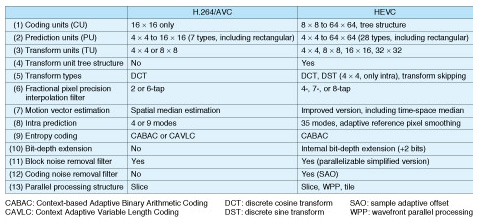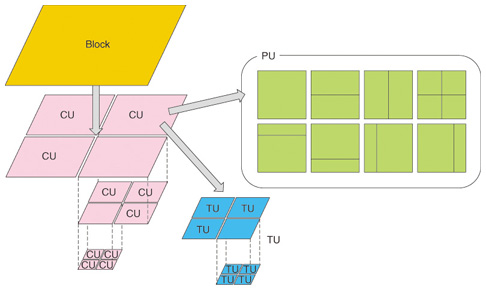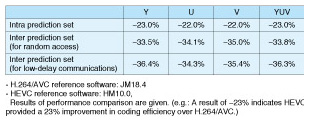 |
|||||||||||||||
|
|
|||||||||||||||
|
Global Standardization Activities Vol. 12, No. 2, pp. 50–56, Feb. 2014. https://doi.org/10.53829/ntr201402gls Standardization Trends for the HEVC Next-generation Video Coding StandardAbstractTen years have passed since the H.264/MPEG-4 (Motion Picture Experts Group) AVC (Advanced Video Coding) standard was established in 2003. With the recent explosive increase in high-resolution video such as 8K Super Hi-Vision (SHV) video, there is worldwide demand for a video coding standard with higher quality compression. The international standards organizations, ITU-T (International Telecommunications Union, Telecommunication Standardization Sector) and ISO/IEC (International Organization for Standardization/International Electrotechnical Commission), have been collaborating on a next-generation video coding standard called High Efficiency Video Coding (HEVC). The basic standard has been completed, and work is proceeding on an extended standard. In this article, we describe the state of HEVC standardization and give a simplified technical description. Keywords: HEVC, ITU-T, ISO/IEC 1. IntroductionIn multimedia, video contains more information than other media, so efficient video compression methods are vital. Existing international video coding standards were created as a result of collaboration between two standardization organizations: the International Telecommunication Union, Telecommunication Standardization Sector (ITU-T), and the International Organization for Standardization/International Electrotechnical Commission (ISO/IEC). The MPEG-2 (Motion Picture Experts Group) standard is the most well-known and widespread standard among them. MPEG-2 was completed in 1995 and is used in a wide range of fields including DVDs (digital versatile disks), hard-disk recorders, and digital broadcasting. MPEG-2 brought efficient video compression, enabling video services to spread around the world, which brought recognition to the importance of video coding standards. After the MPEG-2 standard was completed, work proceeded on the newer H.264/MPEG-4 AVC (Advanced Video Coding) standard (H.264/AVC), which achieves approximately double the coding efficiency of MPEG-2, and this standard was completed in 2003. After that, the H.264/AVC FRExt extension (Fidelity Range Extension) was standardized in 2007, which included support for various input video formats and a High Profile, or HP, with higher compression rates. H.264/AVC has received much industry attention and has been adopted in a wide range of video-related applications such as Blu-ray Discs, One-Seg and HDTV (high-definition television) broadcasting, digital cameras and handy cams, video capture devices, video conferencing, and video upload sites. It is widely used in the communications, broadcasting, and storage fields, and has become one of the foundational technologies used for video services. 2. Standardization activities for next-generation video coding2.1 Trends with the HEVC basic standardThe Joint Collaborative Team on Video Coding (JCT-VC) was inaugurated in January 2010 with members from the ISO/IEC MPEG and the ITU-T VCEG (Video Coding Experts Group), to begin serious work on the High Efficiency Video Coding (HEVC) standard as the next-generation video coding standard. First, a call for proposals of new coding methods satisfying specified requirements (bit rates, latency, etc.) was issued [1], and 27 proposals were received by the February deadline. In March, a focused, quantitative evaluation was done on the subjective quality of decoded video achieved using these methods [2]. In April 2010, the first meeting of the JCT-VC was held in Dresden, and a Test Model under Consideration (TMuC) was settled on, with algorithms in the proposals that ranked highest in the results of the evaluations described above considered as provisional HEVC reference software. Improvements were subsequently added, and official reference software—HEVC Test Model 1 (HM1)—was decided in October of that year. Ongoing technical improvements were made in subsequent JCT-VC meetings every three to four months. Specifically, coding methods proposed within particular domains were gathered, and core testing groups were organized to deliberate on them. Each proposed method was selected or rejected by evaluating them overall using various indices such as: (1) the BD-rate (Bjontegaard Distortion rate), which indicates the amount of improvement in coding efficiency; (2) the processing time for coding and decoding; (3) the memory bandwidth for hardware implementation; and (4) changes in the software source code. As the core test groups were newly established, succeeded in carrying out their tasks, and were disbanded with each meeting, technologies were selected from the various proposals to improve the performance of HEVC. The HEVC standardization process and the topics focused on at each meeting are listed in Table 1.
There are three main steps in establishing a standard: developing the Committee Draft (CD), the Draft International Standard (DIS), and the Final Draft of International Standard (FDIS), in that order. The CD of the HEVC standardization process was issued at the San Jose meeting in February 2012, where most of the technical specifications were decided. The DIS was issued at the Stockholm meeting in July 2012, where most of the specification details were completed. The FDIS was issued at the Geneva meeting in January 2013; it included some minor bug fixes and the completed final basic HEVC specification. The FDIS was approved through a ballot distributed to participating countries and was issued as an international standard in April 2013. As can be seen from Table 1, most of the technical specifications were decided with the CD, so just prior to this at the 7th meeting in Geneva in November/December 2011, there was very high participation from members, and many contributions were added. It is quite rare to have over 1000 contributions for a single meeting, and this indicates the unprecedented scale and amount of activity related to HEVC standardization. 2.2 Standardization activity for HEVC extensionsThe basic HEVC standard discussed in the previous section is limited to input video with a 4:2:0 color format* and does not support 4:2:2 or 4:4:4 color formats. It also supports bit depths of eight and ten bits to express each pixel, but higher bit depths are not anticipated. There is a need to handle video formats that are not supported by the basic HEVC standard, particularly in professional video recording and playback devices and in medical imaging devices, so the standardization of extended standards to support such color formats and bit depths is in progress. These extended standards go through stages corresponding to CD, DIS, and FDIS, which are called the international standard Proposed Draft Amendment (PDAM), Draft Amendment (DAM), and Final Draft Amendment (FDAM), respectively. This standardization is proceeding on a schedule delayed six months from the basic standard, as shown in Table 1. At the Vienna meeting in July 2013, the extended standard DAM was issued, and the FDAM is expected to be issued at the 16th meeting in San Jose, in January 2014.
3. Technical description of HEVC3.1 Basic video coding frameworkThe basic process of video coding for H.264/AVC and HEVC is shown in Fig. 1. The input video is partitioned into square blocks of n × n pixels, and coding is performed in units of these blocks. These blocks are the input in Fig. 1, and are encoded into a bit stream—a binary signal array of 0’s and 1’s—through processes including prediction and orthogonal transformation.
Prediction is a core technique in coding. Consider the example in Fig. 2. In the process of encoding the frame at time t, if the frame at time t-1 has a similar pattern, then only the difference (the prediction residual) between that pattern (the prediction signal) and the source signal, is sent. This concept of using information that is already at the decoder to efficiently compress information is called prediction. Between t-1 and t, the character shown in Fig. 2 moved one block position to the left. When an object moves during the time between one image and the next, a motion vector indicating the amount of movement is sent to the decoder, indicating its predicted position. For objects that do not move, like the cloud shown in the figure, no motion vector needs to be sent. Prediction that spans images in this way is called inter prediction (prediction between images). In contrast, prediction done within an image is called intra prediction (within an image). For example, as shown by the red box enclosing the cloud in Fig. 2, the block to the left is already present at the decoder, so coding is performed using a copy of the pixels on the left as the prediction signal and taking the difference between those values and the source signal. The intra/inter prediction in Fig. 1 is able to significantly reduce the amount of information using these processes, so it has become a core coding technology.
After the prediction process, an orthogonal transform is performed on the prediction residual signal, which converts it to a signal that can be compressed still further. When the signal is transformed into a different signal space called the frequency domain, efficient compression can be achieved by preserving the low frequency components, which express the basic structure of the pattern, and dropping the high-frequency components (Fig. 3).
3.2 New features of HEVCThe differences between HEVC and conventional H.264/AVC are summarized in Table 2 [3]. H.264/AVC performs coding in units of 16 × 16 pixel blocks called macro-blocks, while HEVC does so in blocks of up to 64 × 64 pixels called coding units (CUs). CUs are partitioned into a quad-tree structure, with the leaf elements independently partitioned into prediction units (PUs), which are the unit for prediction, and transform units (TUs), which are the unit for orthogonal transforms. Processing in large units such as the 32 × 32 transforms or 64 × 64 predictions was not possible with H.264/AVC. These large units enable efficient compression, particularly for high-resolution images ((1)–(5) in Table 2 and Fig. 4).
For inter prediction, a scheme has been introduced that enables more accurate prediction signals to be generated. The process of creating signals for objects whose movement cannot be expressed in integer pixel motions is called interpolation, and prediction performance was improved by increasing the number of taps on the interpolation filter to express the motion more accurately ((6) in Table 2), and by improving the prediction methods for the motion vectors themselves ((7) in Table 2). For intra prediction, performance was improved by using approaches such as greatly increasing the number of prediction directions and by applying smoothing filters adaptively when copying the source pixels, depending on the block size or direction ((8) in Table 2). Context-based Adaptive Binary Arithmetic Coding (CABAC) is used uniformly ((9) in Table 2) as entropy coding to binary-encode the information. Also, the bit depth of the input video is increased by bit-shifting it to the left, and this value is used in the coding loop and in orthogonal transform processing. This reduces rounding errors in orthogonal transformation and increases coding efficiency for intra and inter prediction ((10) in Table 2). The source for the predicted signal is called the reference signal. This refers to the t-1 frame in Fig. 2 for inter prediction, and the set of pixels at the leftmost edge of the enlarged red frame at time t for intra prediction. These reference signals are from the decoded signal, so they also have distortion known as block noise superimposed on them. With HEVC, the filters for removing this distortion have been improved ((11) in Table 2). New filters that are not in H.264/AVC have also been introduced. These filters bring the reference signal closer to the original signal, which reduces the prediction residual signal components that need to be transmitted and increases the coding efficiently significantly ((12) in Table 2). A mechanism for efficiently controlling partitioning losses and supporting parallel processing was also introduced ((13) in Table 2), in response to the need to support recent multi-core environments. 3.3 Comparison of coding performanceA comparison of HEVC and H.264/AVC performance using reference software [4], [5] and JCT-VC standard test images is presented in Table 3 [6]. Common conditions were used for the tests, and the results are an average of BD-rates indicating the coding efficiency improvements for a total of 20 images ranging from a 2560 × 1600 pixel high-resolution image down to a 416 × 240 low-resolution image. Y is the luminance signal, U and V are chrominance signals, and YUV is a weighted average of the three. An improvement of approximately 23% was achieved with intra prediction, and approximately 35% with inter prediction (for both random access and low delay communications settings). Looking at the image quality objectively, we found that we did not double the coding efficiency, which would be an approximately 50% improvement comparing BD-rates. However, it was confirmed that when the subjective quality was the same, HEVC achieved approximately twice the coding efficiency of H.264/AVC.
4. Future developmentsWe have described standardization activities and given a simple technical explanation of HEVC, the next-generation video coding standard. Extensions to the HEVC standard will be completed in January 2014, and six months later, HEVC scalability extension standards should be completed. Work on extensions for 3D video is also proceeding steadily. There is strong demand for these technologies in society, so we can expect further developments in the future as well. References
|
|||||||||||||||









